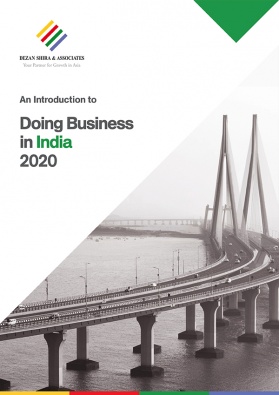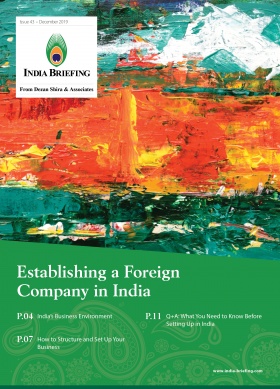India’s PPE Industry: How COVID-19 Demonstrated Untapped Local Production Capacity
- Given the surge in COVID-19 cases, India has ramped up the domestic manufacturing of personal protective equipment (PPE). In a matter of weeks, India went from manufacturing just about 47,000 PPE kits annually, to producing nearly 450,000 units per week.
- This ‘Make in India’ success story demonstrates the country’s domestic manufacturing capacity and that it has the resources to match sudden demand with quality supplies.
- Local manufacturers hope that once India’s local demand is fulfilled, they will be allowed to export PPE kits and profit from growing market demand across the world. At present, India has banned the export of PPE kits for national security and public health reasons.
As cases of COVID-19 began to increase in India, so did the demand for PPE for doctors, nurses, field volunteers, and paramedics. PPE refers to protective gears designed to safeguard the health of medical professionals and other vulnerable groups by minimizing their exposure to a biological agent, such as the coronavirus, despite being in the proximity of those infected. According to Health Ministry guidelines, a PPE kit consists of six items – goggles, face-shield, masks (surgical/N-95), gloves (surgical/examination), coverall/gowns (with or without aprons), head cover, and shoe cover. There are accordingly three types of PPE – industrial, healthcare, and consumer.
As per media reports, India manufactured barely 47,000 PPE kits every year before the pandemic. Once the rate of COVID-19 infections showed no signs of slowing down in India – the country had no option but to begin local production of PPE kits to protect its frontline healthcare workers. In a short period of time, the country jumpstarted its domestic production capacity to start making nearly 200,000 PPE kits and N-95 masks daily. Soon, production increased from nearly 300,000 PPE kits in mid-May to about 450,000 PPE kits per week. The Indian government has ordered 22 million PPE kits; around 14.2 million will be purchased from domestic manufacturers, while the rest will be imported.
However, the PPE kit production run has not been smooth. The quality of the kits initially came under scrutiny as many manufacturers did not have the expertise in producing protective gear. There were concerns around product specifications, packaging, and standardization.
Despite the early hiccups, India has shown that it can become a leading PPE manufacturer, if production issues concerning quality are resolved timely and effectively. As per the Indian government’s estimate, the country is already the world’s second largest manufacturer of PPE body coveralls, next to China.
This article will explore the potential of the PPE industry in India, including how the country stepped up its production, opportunity for foreign investment in the industry, ideal locations for manufacturing PPE kits, and major concerns for foreign investors.
How India ramped up its PPE production
In early March, the World Health Organization (WHO) announced that the world was experiencing an acute shortage of PPE kits. India, too, at that time was relying on imports for its PPE requirements.
India began exploring its domestic manufacturing potential, and a month later – by April – production capacity increased to making 12,000 units a day. This then jumped to making around 200,000 units a day in the first week of May. Within two weeks, India had more than doubled its production, now producing nearly 450,000 PPE kits on a daily basis.
Until the first week of May, the government had identified 110 domestic manufactures of PPE kits. While initially only 52 companies were producing the kits, such as Alok Industries, Aditya Birla, JCT Phagwara, and Gokaldas Exports, now there are over 600 companies in India certified to manufacture PPE.
The PPE industry jumpstart has resurrected the ‘Make in India’ model, and follows as the government aims to attract foreign investors exiting China to consider India as a viable destination for their production and operations.
India, which has been infamous for its complex bureaucracy, took only a few days to certify domestic PPE manufacturers, with initial delays only due to strong testing standards – this experience could attract foreign investors grown wary of the country’s promises in the past.
India is also responding quickly to concerns over quality. In early April, after reports emerged that Indian manufacturers, who failed laboratory tests, sold their rejected products to some private hospitals, the textile ministry announced a new framework for PPE production. According to the new norms, a Unique Certification Code (called UCC-Covid19) and a tamper-proof sticker in indelible ink specifying the details of the manufacturer has to be printed on PPE kits. The code will record the type of garment, its test procedure, and also the date of the test.
Apart from the textile ministry, the health ministry and the department of pharmaceuticals are also working with “industry bodies, stakeholders, and manufacturers on 24X7 basis, to streamline the supply chain, remove bottlenecks, and maintain a steady supply of all materials required for healthcare professionals,” as per an official statement by the government.
What are the opportunities for investors?
The Apparel Export Promotion Council (AEPC) has projected India’s PPE industry to grow into a INR 100 billion (US$1.31 billion) industry this year itself, and a US$60 billion global business in the next five years.
While the export of PPE products is currently banned in India, AEPC has submitted a request to the government stating that local manufacturers should be allowed to export once the Indian market demand is met.
The firms manufacturing PPE echo similar sentiments. For instance, around 200 units in Tiruppur, a city in Tamil Nadu and considered South India’s cotton knitwear capital, are manufacturing PPEs with the hope that once they get the relevant technology, they can soon be a part of the export market. Experts point out that for such leaps in production to meet external market demand, Indian manufacturers will need to import seam sealing machines for their factories.
The production of PPE kits in India started as a contingency plan, but enterprising manufacturers have used the opportunity to create supply chains that did not exist before.
India was able to identify new manufacturers in a short span and help existing PPE kit manufacturers and micro, small, and medium enterprises (MSMEs) to expand their production. Once the domestic requirement is fulfilled, India should turn its sights to the export market, which will open up avenues for investment in this industry. Moreover, PPE kit production is a start – and soon manufacturing should expand to meet related segments.
The manufacturing industry will benefit from the recent reduction in the corporate tax rate to 15 percent (with an effective tax rate of around 17 percent after including surcharge and cess) for new companies.
As India strives to compete with China for sourcing PPE kits, it is likely that the government will provide incentives and support to firms who enter into production of PPE.
Where PPE production units are located
Bengaluru (formerly known as Bangalore), capital of Karnataka, has emerged as a hub for producing PPE coveralls, that are needed for healthcare professionals treating COVID-19 patients. According to the government, nearly 50 percent of the coverall production in the country is being sourced from Bengaluru.
Firms venturing into producing PPE kits can also look at India’s textile hubs to set up manufacturing entities as several apparel and garment businesses are also looking at producing PPE kits. India’s textile hubs are spread across several states – Gujarat, Uttar Pradesh, Karnataka, Rajasthan, West Bengal, Andhra Pradesh, Telangana, Jharkhand, and Madhya Pradesh.
Besides Bengaluru, other cities in India manufacturing PPE kits or PPE products include – Tiruppur, Chennai, and Coimbatore in Tamil Nadu; Ahmedabad and Vadodara in Gujarat; Amritsar, Phagwara, and Ludhiana in Punjab; Kusumnagar and Bhiwandi in Maharashtra; Dungarpur in Rajasthan; Kolkata in West Bengal; and the capital Delhi and its neighboring suburbs of Noida (Uttar Pradesh) and Gurugram (formerly known as Gurgaon, in Haryana). It will be easier for new PPE manufacturers to find the necessary expertise, raw materials, and labor in these cities.
Interested manufacturers will have to seek a certification for their products from the Ministry of Textiles and be quality approved by a government-accredited laboratory (more details in the following section). The other regulatory requirements depend on the specific item being produced.
Overcoming concerns regarding PPE quality and supply
There initially were a number of concerns with regards to the quality of PPE kits produced in the country. At the start, there was a lack of knowledge on how to produce protective gear to match the sudden overwhelming demand and meet quality standards. Subsequently, several young manufacturers did not meet the right specifications – they were mixing and matching items to cut costs. According to India’s health ministry guidelines, it is important that a PPE kit has all the six items, as mentioned earlier.
The PPE kits must be quality certified from government approved labs. Currently, there are eight such labs across the country, including the South India Textiles Research Association (SITRA). However, experts point out that these are certification bodies, and that they only issue test reports for the prototype sample, for example, PPE coveralls. So, the buyer is forced to do its own due diligence before any purchase, increasing the risk of supplying faulty PPE products in hospitals.
Doctors and healthcare workers across the country have also complained about the shortage of PPEs – therefore closing the door on exporting for now. Apart from the shortages, other issues include late supply, or poor quality and packaging, or uncomfortable to wear. Addressing these concerns is vital for India’s manufacturers as the association of quality with production is key to establishing market preference.
About Us
India Briefing is produced by Dezan Shira & Associates. The firm assists foreign investors throughout Asia from offices across the world, including in Delhi and Mumbai. Readers may write to india@dezshira.com for business support in India.
- Previous Article Investing in India’s Online Gaming Industry: Market Profile, Growth Drivers
- Next Article The Fitness Industry in India: Investment Outlook After COVID-19








